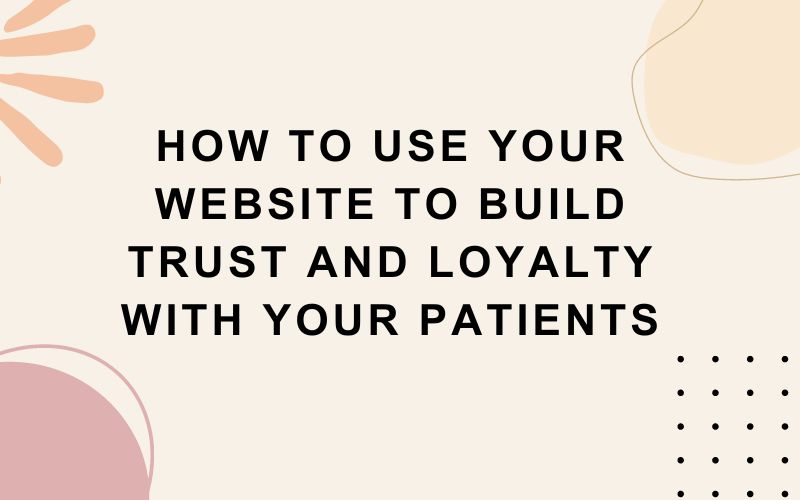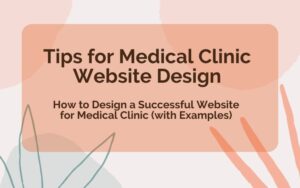A well-designed website is not just about looks. It’s a powerful tool for improving patient loyalty and building trust.
Your website plays a crucial role in shaping their perception of your wellness practice.
By implementing time-tested strategies described in this post, you can create a website that will build trust, engage visitors, and cultivate long-term loyalty.
Explore the essential features of a healthcare website that contribute to building trust and loyalty with your patients.
1. Build Trust By Educating and Engaging Your Patients
A successful healthcare website goes beyond providing basic information about your practice; it should also offer valuable content that educates and engages your patients. By sharing general health tips, industry updates, promotional offers, and video tutorials, you can keep your patients informed and encourage them to return to your website for new and useful information.
Creating a blog section on your website is an effective way to showcase your expertise and establish yourself as a trusted authority in your field. Your marketing team can consistently update your blog with informative articles that address common health concerns, debunk myths, and provide practical advice. By offering valuable content that resonates with your audience, you can build credibility and foster loyalty among your patients.
2. Establish Credibility Using Trust Signals
As your virtual storefront, your website’s design plays a crucial role in building trust with your visitors. A professional and visually appealing design, coupled with trust signals, can significantly impact how visitors perceive your practice.
Include trust badges and logos on your website to demonstrate that your website and patient data are secure. These badges can be obtained from well-known security companies, payment providers, or industry organizations. By displaying these trust signals, you reassure visitors that your website has undergone scrutiny and meets industry standards for security and privacy.
Additionally, consider creating an “About” page that provides information about your practice, its history, and the qualifications and expertise of your healthcare professionals. This page allows newcomers and current patients to learn more about your practice, fostering transparency and instilling trust. Including a blog section where you share valuable insights and updates can further establish your credibility and expertise in the field.
3. Engage with Your Patients On Social Media
Social media has become an integral part of our daily lives, and it provides an excellent opportunity to connect with your patients and build relationships outside of your website. By integrating social media buttons on your website, you can encourage visitors to share your content on their preferred platforms, expanding your reach and attracting more followers. This increased engagement can lead to more website visits and ultimately convert visitors into loyal patients.
Your marketing team can develop a social media strategy that aligns with your practice’s goals and target audience. By curating and sharing valuable content related to your field, you can position your practice as a reliable source of information and expertise. Additionally, by incorporating your preferred topics of content into your social media posts, you can encourage sharing and drive more traffic to your website. This consistent presence on social media platforms will contribute to building trust with your healthcare patients.
4. Easy and Accessible Contact Information
Providing clear and easily accessible contact information is crucial for building trust and facilitating communication with your patients. Some patients may need to reference your website to find your phone number or address, while others may prefer alternative methods of contact. By prominently displaying your contact details, such as phone numbers and email addresses, you can encourage patients to reach out to you with any inquiries or appointment requests.
To enhance the user experience, consider including a dedicated “Contact Us” page on your website. This page should provide comprehensive information about your practice, including multiple contact methods, office hours, and even a map with directions. By making it easy for patients to find and contact you, you demonstrate your commitment to providing quality care and foster trust in your practice.
5. Build a Responsive, User-Friendly Website
With the widespread use of various internet-enabled devices and browsers, it is vital to ensure that your website is accessible and functional across all platforms. A responsive design adapts seamlessly to different screen sizes, ensuring a consistent user experience for patients using desktops, laptops, smartphones, or tablets. By optimizing your website for mobile devices, you can reach a broader audience and provide a user-friendly interface that meets the expectations of today’s tech-savvy patients.
Your marketing team, equipped with the necessary technical expertise, can handle the design and maintenance of your website. Their role is to ensure that your website is responsive, loads quickly, and functions flawlessly across different devices and browsers. By providing a smooth and intuitive user experience, you can prevent frustration and instill confidence in your patients, ultimately enhancing their loyalty to your practice.
6. Harness the Power of Word-of-Mouth
One of the most cost-effective ways to build a patient base is through customer referrals. A well-designed website can facilitate and encourage patients to refer your practice to their friends, family, and colleagues. By incorporating a referral program on your website, you can incentivize patients to share their positive experiences and recommend your services to others.
Your marketing team can create a dedicated referral page on your website that outlines the benefits of referring your practice and provides clear instructions on how to refer. Additionally, consider featuring patient testimonials and success stories on your website to showcase the positive outcomes of your services. By leveraging the power of word-of-mouth, you can attract new patients and strengthen the trust and loyalty of your existing ones.
7. Set Up User-Friendly Navigation
A user-friendly website is essential for building trust and loyalty with your patients. Your website should have a clear and intuitive navigation structure that allows visitors to find the information they need quickly and easily. Complex navigation or hidden information can lead to frustration and a loss of trust.
Ensure that your website’s layout is clean and organized, with clear headings and subheadings that guide visitors through the different sections. Use descriptive labels for navigation menus and buttons, making it clear where they will be directed when clicked. Consider incorporating a search function on your website, allowing visitors to quickly find specific information or services.
By providing a user-friendly experience, you demonstrate your commitment to delivering quality care and attention to detail, fostering trust and loyalty with your patients.
8. Tailor Website Experience to Individual Patients
Personalization is a powerful tool for building trust and loyalty with your patients. By tailoring the website experience to individual patient’s preferences and needs, you can create a more engaging and personalized journey.
Consider implementing features such as personalized recommendations based on patients’ browsing history or previous interactions with your website. This can help patients find relevant information, services, or products more efficiently. Additionally, allowing patients to create personalized accounts where they can save their preferences, manage appointments, and access personalized content can further enhance the sense of personal connection and loyalty.
9. Improve Speed and Performance
A slow-loading website can significantly impact the user experience and erode trust. Patients expect websites to load quickly and provide a seamless browsing experience. To ensure optimal speed and performance, optimize your website’s code, compress images, and minimize unnecessary scripts and plugins.
Regularly monitor and test your website’s load time and performance, making any necessary improvements to enhance the user experience. A fast and responsive website reinforces the perception of professionalism, reliability, and trustworthiness.
10. Prioritize Data Privacy and Security
In the healthcare industry, data privacy and security are of utmost importance. Ensuring that your website is compliant with relevant regulations, such as HIPAA (Health Insurance Portability and Accountability Act), is crucial for building trust with your patients.
Work with your marketing team and web designer to implement robust security measures, such as encryption protocols and secure data storage. Regularly update your website’s security features and educate your staff on cybersecurity best practices. By prioritizing data privacy and security, you demonstrate your commitment to protecting your patients’ sensitive information, strengthening trust and loyalty.
11. Monitor and Analyze User Feedback
Using your website to build trust with your patients is an ongoing process that requires continuous improvement and adaptation. Actively seek and analyze user feedback to identify areas for improvement and address any concerns or issues promptly.
Implement feedback features on your website, such as surveys, comment sections, or customer support chatbots, to encourage patients to share their thoughts and experiences.
Regularly review and analyze this feedback to gain insights into your patients’ needs and expectations. Use these insights to refine your website design, content, and overall patient experience, further strengthening trust and loyalty.
12. Embracing Telehealth and Digital Innovations
The healthcare landscape is continually evolving, and embracing technological advancements is essential for building trust and loyalty with your patients. Telehealth services, for example, provide convenient and accessible healthcare options for patients who cannot visit your practice in person.
Integrate telehealth features into your website, allowing patients to schedule virtual appointments, access medical records, or seek remote consultations. Emphasize the benefits and convenience of telehealth on your website, demonstrating your commitment to meeting patients’ evolving needs and preferences.
Stay on top of digital trends and leverage the latest technology to improve patient experiences.
Conclusion
A well-designed website is a powerful tool for building trust and loyalty with your patients. By implementing responsive design, social media integration, providing valuable content, and personalizing the user experience, you can create a website that engages and nurtures your patients.
By following these strategies and adapting to the evolving needs of your patients, you can establish a strong online presence and position your healthcare practice for long-term success.
Subscribe to our newsletter to stay updated on the latest trends in website design for healthcare and receive actionable insights to enhance your practice’s online presence. Contact us today to get started on optimizing your website!






